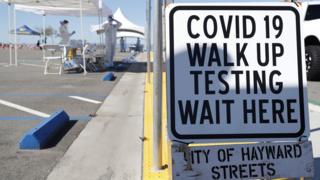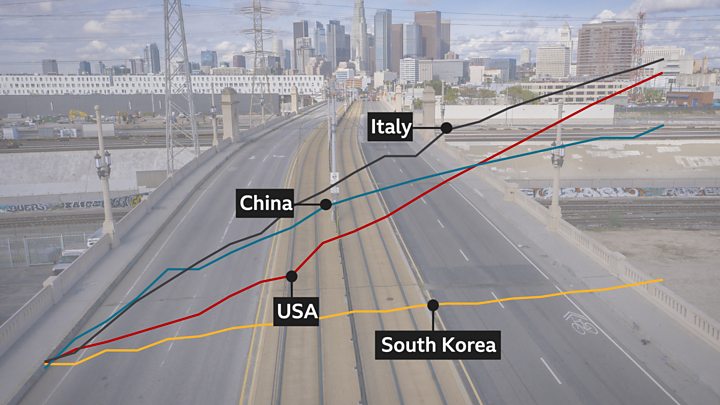 Image copyright
Image copyright
EPA
President Trump says “we’ll be the comeback kids”, but scientists warn easing restrictions won’t be quick or easy – the US still lacks the capacity to test and track infections on the scale needed.
Americans are watching anxiously as Europe slowly opens back up from lockdown. There is intense pressure from the White House and business leaders here to get things moving again as soon as possible. But proposals to do so are fragmented and unclear.
There is a general recognition that it may take the US longer to get out of this than other countries, partly because the country is so large and partly because it responded later than other countries. Shutting down late meant the virus had already spread and so it takes longer to get it out of society.
“A late mover is the worst of all worlds,” says Tom Bossert, former national security adviser to President Trump.
Mr Bossert helped develop the pandemic response plan that President George W Bush asked for back in 2005. He has been obsessed with the threat of a pandemic like this ever since and raised the alarm to the White House at the end of February, but didn’t get much of a hearing.
What can be done before we have a vaccine?
Experts agree the Holy Grail is a vaccine to prevent infection or medical therapies to cure it. “It’s over when we have a vaccine,” New York Governor Andrew Cuomo said at his daily press conference on Wednesday. But, he added, that vaccine is 12-18 months away.
In the meantime, US scientists want more data before they will be confident they can reopen the economy without the virus flaring right back up again.
They want to know how many people are infected. They want to know more about whether people who’ve been infected are then immune and if so for how long.
Dr Peggy Hamburg, who ran the Food and Drug Administration under President Obama, says the idea is that “we can test for antibodies (immunity) and then send people back into the economy.” But she warns, “we’re not there yet to do that with confidence.”
But she says two upcoming studies from Westchester country, New York, and Santa Clara county, California, could provide more information on antibodies and immunity.
How do we build up immunity if staying at home?
The longer the country is shut down the more the economy suffers but also the fewer people are infected. That’s good for protecting the health system but health experts point out that there’s some conflict because it doesn’t allow people to develop immunity in large enough numbers to reach so-called herd immunity.
The former head of the Centers for Disease Control, Tom Frieden, believes that even in the hotspots like New York, only 5-10% of people have been infected. To get herd immunity 60% of the population needs to have been infected.
Mr Bossert says America may have to reopen without the amount of data that scientists would like to have because the economic cost of staying shut for long enough to get that data is just too high.
He also warns that there will not be enough tests in America by the end of April to reopen the country with the kind of confidence political leaders would like to have.
Should we test people with no symptoms?
Mr Bossert advocates an approach that presumes people who have flu symptoms are Covid-19 positive and so isolating them. Then, using what virus tests are currently available, he suggests selectively testing people who have no symptoms, and those who are asymptomatic but test positive would also be isolated.
Something similar is already happening in Seattle, where the Seattle Coronavirus Assessment Network sends test kits to a representative sample of households to ensure that asymptomatic individuals who have the virus are found.
Isolation could potentially take place in facilities like unused hotels, college dorm rooms or excess hospital beds. (Mr Bossert warns that Americans may not do isolation properly if they have an option to stay home, which begs the controversial question of whether isolation should be voluntary or enforced.)
Combine those two groups – presumed positive and asymptomatic positive – and you can remove a big chunk of the virus from circulation.
Will the US be able to test and track everyone?
However you chose to test, everybody wants a lot more testing. The US is currently testing about 100,000 people per day. Harvard University’s Safra Center says the US needs to test 5 to 20 million people per day.
Economist and Nobel Laureate Professor Paul Romer at New York University believes it’s even more – he says the US needs to conduct 22 million tests per day.
The number is so high, he believes, because individuals will need to be tested and retested. For some perspective, Prof Romer’s estimate is a massive 220 fold increase on today’s capacity.
There’s also a growing realisation that beyond testing, America will need to do a much better job of tracking down the people that infected individuals have come into contact with. That’s what South Korea, Singapore and Hong Kong did so successfully.

Media playback is unsupported on your device
It’s a labour intensive process. Governor Cuomo makes the point that for each individual who tests positive you may have to find up to 30 more people they came into contact with and may have infected.
There’s no federal effort to recruit and train those contact tracers.
Partners in Health, a non-profit group in Boston that usually works in developing countries, is recruiting 500 people to do contact tracing. San Francisco has only 10 people qualified to do contact tracing – it just recruited another three dozen volunteers to help out. But Dr Frieden estimates the US may need 300,000 contact tracers.
Technology can help, but what about civil liberties?
Since the virus is already so widespread here, the US may have to rely on technology as well as human labour to do the contact tracing. Apps were used in South Korea and Singapore.
In its six-step plan for lifting the lockdown, the liberal leaning Center for American Progress advocates technology but adds that for the US it must be a more “civil-liberties-sensitive” solution that puts privacy protections in place. The data, it says, should be stored by a trusted, non profit organisation and deleted after 45 days.
Other think tanks have similar reopening plans that all advocate for some combination of widespread testing, tracing and quarantine, with more or less protection of privacy.
The conservative leaning American Enterprise Institute says that states can only move to reopening businesses and schools when they have a sustained reduction in cases for 14 days and their hospitals can cope without being in crisis mode.
No American state is there yet.





543203 10802Spot lets start work on this write-up, I truly believe this amazing site requirements much far more consideration. Ill apt to be once again to read a fantastic deal more, a lot of thanks for that info. 488534